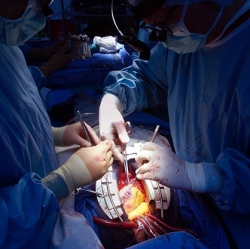
Nearly a decade ago, Jeffrey Karp was playing around with a new, biodegradable polymer he’d made. He was a post-doctoral researcher at MIT. He ended up gluing together two pieces of glass… but later forgot about it. He ultimately developed the material for something else (as a scaffold for growing artificial organs, if you’re curious).
"It’s critical in science to be focused and to advance projects with, you know, scientific rigor, so I didn’t have time to explore all of these kinds of side projects," Karp, who’s now a researcher with Brigham and Women’s Hospital in Boston, tells Popular Science.
Then he met Pedro del Nido, a cardiac surgeon at Boston Children’s Hospital. Del Nido specializes in sealing up children’s heart defects, literally holes in the heart that shouldn’t be there. He wanted to know if Karp could make a surgical glue that would work in the heart. It was a tall order: Such a glue would have to be biodegradable, safe for use inside the body, a bit stretchy, and strong enough to hold onto a beating muscle continually awash in blood.
Karp remembered the cell scaffolding that could glue glass together. He started with that, and from there, he worked with del Nido and a team of surgeons and engineers to develop a glue that they recently tested in hearts of living rats and pigs. The glue is made of body-friendly chemicals that cells normally produce. In the future, del Nido hopes, this could become a gentler alternative to the stitching doctors rely on for many surgeries. "All the needles and the thread, they themselves cause injury to the healthy tissue," he says. "We’ve always have looked for a way to glue things together."
